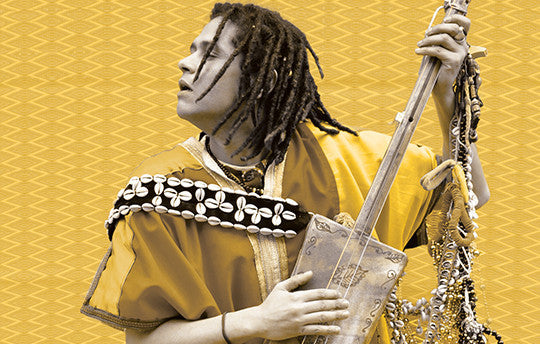Your Cart is Empty

Monday 20 October sees the release of Simo Lagnawi's album on Riverboat Records: The Gnawa Berber. All across Morocco the Berber yaz symbol is etched into the country’s red rolling mountains and stretching Atlantic and Mediterranean coastlines. This universal sign can be spotted in graffiti sprayed rebelliously onto crumbled city walls, hanging as pendants on the necks of proud Berber people, above their home doorways, or dangling from their rear-view mirrors. The good-luck emblem represents a ‘free man’, the meaning of the word‘Amazigh’, the Berbers’ name for themselves.
Simo Lagnawi is of Berber heritage and embodies these cultural sentiments of freedom and liberation perfectly. He has travelled across his North African homeland, learning gnawa grooves and ahwash chants from teachers and friends along the way. As Simo puts it, ‘some people learn from just one mâalem [gnawa master] … I learned with lots of different masters’. This approach has impressed Simo’s music with a breadth of sound influences that span everything from the gnawa tradition to South Moroccan folk and sub-Saharan lute styles; on this album stretching further to include banjo and Scottish fiddle.
Seamlessly infusing his Berber origins with deep gnawa grooves, Simo Lagnawi’s trance-inducing music is an unstoppable expression of freedom and liberation.
'powerful rhythmic grooves' 4****stars - The Evening Standard
It is impossible to underplay, however, the deep-reaching influence Moroccan gnawa has had on Simo’s sound. Like the yaz, gnawa is ubiquitous in Morocco: the instantly recognisable percussive grooves that wind around snaking souk paths, pound out of street-side sound systems and are performed late-night in communal squares by local troupes pitched up alongside fortune-tellers, game-makers and snack-sellers. Gnawa is both an ethnic group and a cultural tradition that can be traced back to the slaves brought to Morocco from sub-Saharan Africa and the ancient empire of Ouagadougou. The krakebs percussion, so omnipresent in gnawa, create the hypnotising clip-clopping sound that loops under the texture. These instruments have their origins in the iron manacles that shackled the slaves together on their ill-fated journey northwards. Simo says: ‘When my mother was pregnant my grandmother dreamed that the baby was playing the krakebs before she even knew if it was a boy or a girl.’
Simo’s main instrument, the guembri, is a three-stringed plucked lute from Morocco. The body of the instrument is carved from hollowed wood covered with taut camel-skin; goat gut strings are flexed across the resonator.
After studying his craft in Morocco, Simo decided to travel to the UK in 2008. On arrival he busked on the rain-soaked streets, attracting crowds with his Technicolor clothes and elastic acrobatic displays, before picking up his guembri and singing out his unique brand of gnawa fusion. His enthusiastic musical evangelism has led him to collaborate with musicians from all over the world including Japanese producer DJ Koichi Sakai, Jally Keba Susso from Gambia and Amadou Diagne from Senegal. As part of his quest to bring Moroccan culture to the UK, Simo has also kickstarted his own ‘School of Gnawa’. In a creative corner of London’s East End Simo holds krakeb classes, gnawa tutorials and far-out world music jams.
On this Riverboat Records release Simo’s live energy and thirst for unusual international collaborations reaches symbiosis with his classic gnawa vibrations. Simo Lagnawi, free man, states his musical mission on this outstanding album.